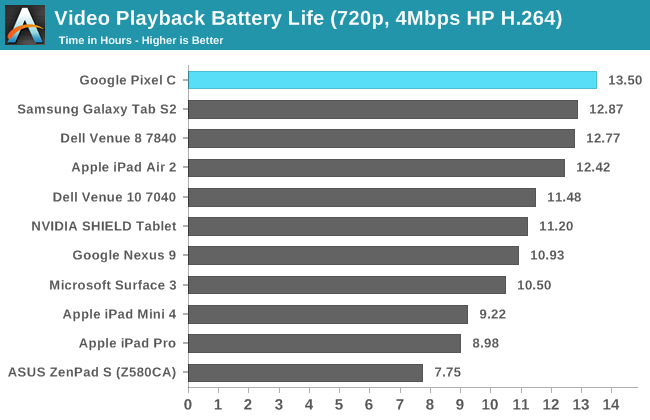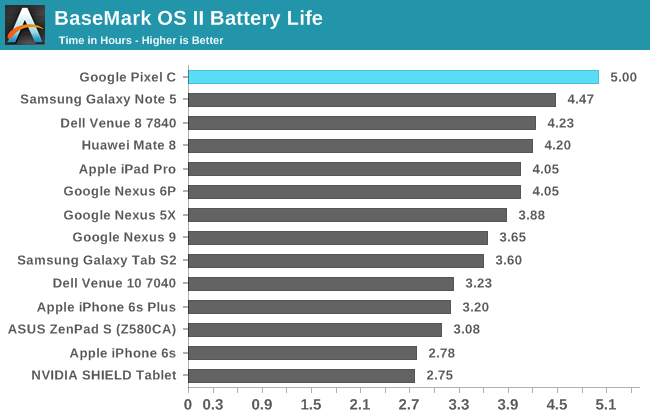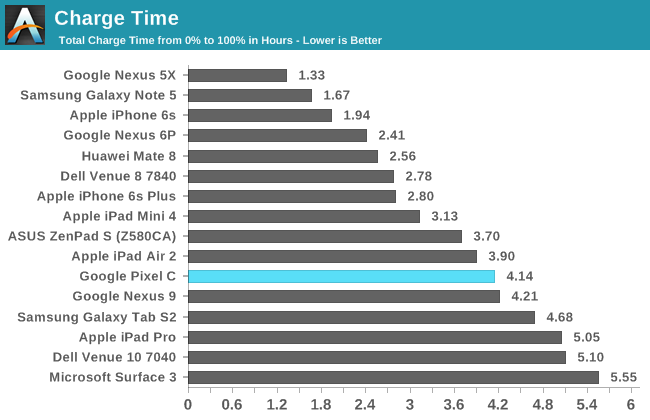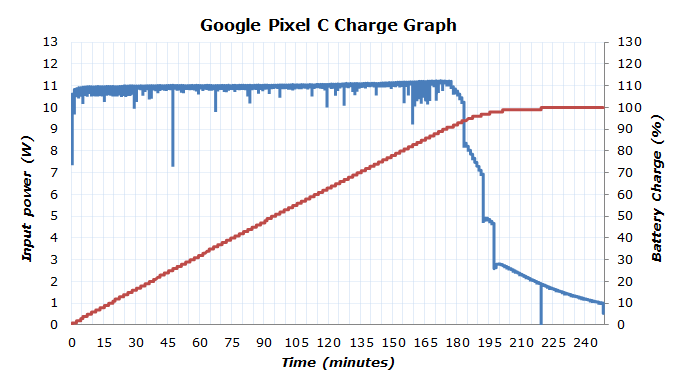The Google Pixel C Review
by Brandon Chester & Joshua Ho on January 25, 2016 8:00 AM ESTBattery Life
When Apple unveiled the iPad, they promised that it would achieve 10 hour battery life. That has been something of a standard for tablets now, and for the most part we've seen that high end tablets end up meeting that goal, while mid range ones often end up falling short of it. 2015 was a bit of an exception to this in some ways, with many high end tablets also missing this goal by several hours in some cases. Due to the nature of tablets and how they're used, it's really difficult to recommend one if it doesn't achieve enough battery life to last you through the day with a normal workload.
To test the Pixel C's battery life I've attempted to run it through all of our battery tests. First up is our internal web browser test, followed by our video playback battery test.

It's clear that Google's use of a LTPS display and a large battery pay off big time when you look at battery life. Even with the SoC staying on its higher-power A57 cores, the Pixel C manages to last for over 13 hours in our web browsing test. This puts it ahead of every other tablet on record, and by a large margin too.

In video playback the Pixel C once again comes out on top. This is quite surprising, as normally AMOLED tablets perform best in this test due to their ability to turn off pixels when displaying black, as well as their general efficiencies with darker colors and shades. The gap between the Pixel C and the Tab S2 isn't insignificant either, so Google should be very happy with what they've achieved here.

In BaseMark OS II's CPU-bound battery test we again see the Pixel C top the charts. This is really surprising to me, because on the SoC side we're looking at four Cortex A57 cores on a 20nm process. Again, Google's large battery and LTPS display help a great deal, but it's also clear that Tegra X1 isn't causing any significant problems for the Pixel C as far as power consumption goes.
At this point I would normally continue to run our PCMark and GFXBench battery tests. Unfortunately, the Pixel C's software makes it incapable of completing either of them. I made five attempts to complete PCMark, which took a great deal of time as the test runs over many hours. In all cases the tablet locked up during the test and required a hard reboot. It may be possible to eventually get it to complete, but I didn't feel that it was worth delaying the review further in the hopes that I could eventually get the Pixel C to complete the test properly.
As for GFXBench, it instantly stops due to it detecting that the tablet is plugged in. I believe this may relate to Google's system for inductive keyboard charging, but whatever the cause may be the result is that I can't get a battery result for GPU-bound workloads either. It's worth noting that the web test also required several runs before I could get it to complete the test without the tablet crashing, so that's something to think about as far as software stability and reliability goes.
In the end, what I have seen of the Pixel C's battery life leads me to believe that it's quite good, but we're definitely not looking at the entire picture here due to the missing data. I can say that in my experience it seemed to last a long time, so if I had to go out on a limb I would say that the combination of the low power LTPS display panel and a relatively large battery allow for very good battery life even with the CPU running on its A57 cores. Since Tegra X1 has a great deal of GPU power I really wish I could have gotten a GFXBench battery result, but there's not much that can be done there.
Charging
Since tablets usually offer enough battery life to get through the day, being able to charge them incredibly quickly becomes less of a need than with smartphones because you'll often end up only charging your tablet overnight. That being said, the immense charge time required by older tablets which required larger batteries to power their SoCs and displays meant that if your tablet battery did die you probably weren't going to get to use it until the next day. With modern tablets we've seen a push to reduce battery capacity, as well as the inclusion of 10-15W chargers to reduce charge times.

The Pixel C ships with a 15W charger with a USB Type-C connector. The cable is actually fixed to the block, so you can't use it as a normal Type-C to Type-C cable. On the bright side, Google has used a cable which is around four feet long, so you get some extra length compared to using the included cable in the box. As you can see in the graph above, the battery is charged at around 11W while fast charging, which lasts for three hours before trickle charging begins. Getting the remaining 10-15% ends up taking another hour, with the total charge time from 0% to 100% being 4.14 hours. Considering that the Pixel C packs a noticeably larger battery than the iPad Air 2, the roughly four hour charge time is actually quite a good result.











122 Comments
View All Comments
valentin-835 - Monday, January 25, 2016 - link
The tablet has issues. You kind of get what you pay for. I mean, it's half the price of an IPad Pro. And less than half that of a Surface.The biggest drawback however is the lack of an advanced graphics API like Metal or DX12. Without that, they are dead in the water. I heard Google is pushing hard to get Vulkan released. Both drivers and specification should be out soon.
styleruk - Monday, January 25, 2016 - link
Hmm, there seems to be an awful lot of points about a Google tablet or android tablet not being much more than a big phone. I have to disagree. I use the N9 for business and pleasure. I often type out reports on the N9 at airports, watch movies, read mags, books and play occasional games. I've had both android and apple phones both have good and bad points, currently on apple phone, but at work there are 2 iPad tablets I could use if I wanted, but they are simply too restricted to my needs. For me, the N5 + Google's more open approach is far more efficient. Up to now, I've had no problem with lack of multi task... to fill in my diary and read an email is simply to switch...its no biggie. If I want more I wait until I'm in front of a PC at work or home.I also like the way everything Google works together well.
Regarding this device, I'm on the cusp of upgrading my N9, but quite why I can't see yet. Until I actually pick it up and try it, I'm not ordering it, as the last upgrade was from the N7(2013), to N9, and whilst bigger, it's not really faster. On paper, the pixel C is not much faster than the N9!
The jury is still out...but stop saying that android tablets are just big phones, I have the choice and I don't agree at all.
tuxRoller - Monday, January 25, 2016 - link
Just looking at the benchmarks, your not judging this device fairly.The nexus 9 had a processor that was basically designed for benchmarking and nothing else. It just falls on its face when the code becomes branchy. Iow, benchmarks were an unusually poor indicator of typical performance.
That aside, the pixel is performs pretty much exactly where you'd expect it to perform given its CPU: between the nexus 5x and the 6p FOR MOST TESTS.
Iow, no surprises.
I'd also like to point out that the weight is only an issue if you have some physical issues, or are just used to very light tablets. I received the pixel c for Xmas and have had no issues transitioning to it from the 2013 nexus 7. My gf even noted when she first picked it up that "this isn't very heavy" (she'd read the reviews which complained about its weight).
I certainly have issues with it (it often doesn't respond to touches, sometimes the interface becomes so slow I have to force a restart) but it's still an awfully good TABLET for the price.
c4v3man - Monday, January 25, 2016 - link
I gave up on waiting for a return to sanely priced android tablets and went with a Dell Venue 11 Pro 7140. Like most non-apple products they don't hold their value particularly well, so I was able to score a Core 5M71 256GB SSD version with the keyboard for under $600. While heavier than initially anticipated, I get excellent battery life (13+ hours real world display use with the keyboard battery), and an extremely snappy tablet that even handles light Adobe Lightroom usage. That and it works on a lap, unlike a Surface, and is serviceable (good luck replacing the battery/ssd in your surface). Remix OS works on it as well if I need to get my android fix, and will likely get better with more development. I guess I don't see the point of using a more limited OS on a $500+ device... If you're going for productivity and charging a premium, give me a full experience. If it's a limited experience, it better come with a "limited" price.Jerch - Monday, January 25, 2016 - link
Always sad to see the Nexus 7 (2013) omitted from display lists, since even though it is now firmly outdated, it had a great screen that would still be at the top of some of these tests -- notably max brightness. It's the perfect beach tablet. Cheap, durable, and BRIGHT.EludiumQ36 - Monday, January 25, 2016 - link
I have a 32GB Pixel C and take it from a regular user as opposed to a professional reviewer/critic - it's a very good tablet. I use it as a true tablet sans keyboard which mitigates much of the complaining. It features a beautiful and very responsive display (utilizing Android 6.0.1). It was my perfect choice because (1) the Nexus 10 is no longer available, (2) it's far less expensive than the 10-in Samsung tablets (which are stuck on KitKat), and (3) it's basically a Nexus with first-in-line upgrades. Having said that, there is a highly reported problem of Wifi performance degradation - I experience a 60% hit but still get 26Mbps to it, so... - but they'll issue a fix for that soon enough. I highly recommend it if you count yourself as a "regular" user.R. Hunt - Tuesday, January 26, 2016 - link
Granted, Samsung is not great with updates. That out of the way, even last year's Tab S is been on Lollipop for months. And how is this less expensive than say, the Tab S2?Jumangi - Monday, January 25, 2016 - link
Google just doesn't care about making Android a good experience on larger tablets. Until,they do we will get half baked products like this and the iPad will continue to be the standard.McChen - Tuesday, January 26, 2016 - link
One thing that wasn't mentioned in the review is that the Pixel C supports faster charging (12V @ 2A, 24W) via USB PD using a charger such as the Pixel laptop charger. I have one and indeed the tablet charges very fast with it. I believe one of the Google engineers said it charges 0 to 100 in about 2.5 hours, compared to just over 4 hours in this review with the standard 15W charger. Would be interesting to see a charging time test with a USB PD charger.Jumangi - Tuesday, January 26, 2016 - link
They used the charger the device comes with as they should.